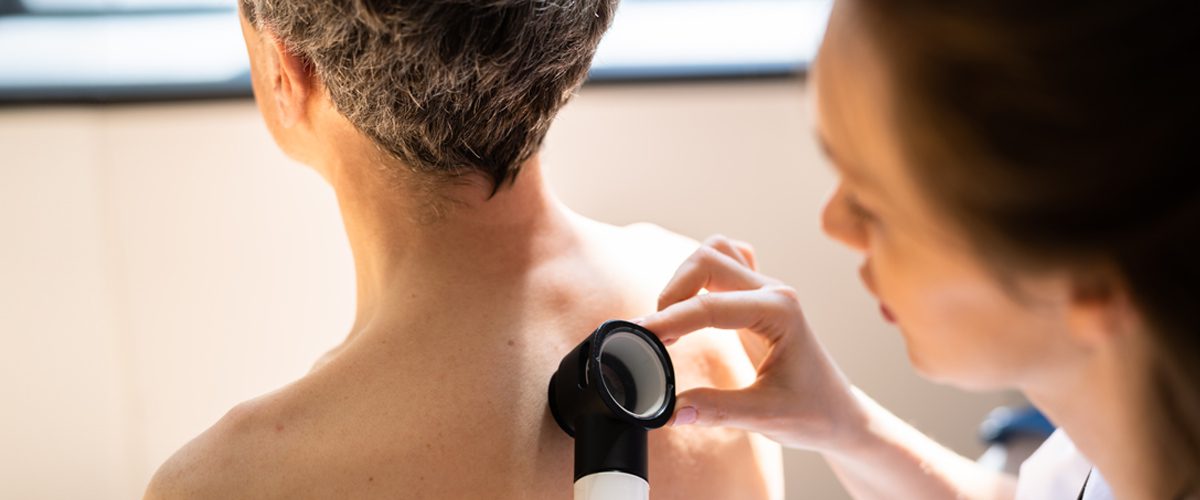5 Facts About Merkel Cell Carcinoma
A dermatologist shares what to know about this rare but aggressive type of skin cancer.

Merkel cell carcinoma is a rare form of skin cancer that occurs when specialized skin cells known as Merkel cells grow out of control. There are only about 3,000 new cases diagnosed each year in the U.S., but more people have become familiar with it after headlines revealed singer Jimmy Buffett died from the disease.
“Merkel cells are found deep in the epidermis, which is the top layer of our skin,” explains Dr. Larisa J. Geskin, a dermatologist at NewYork-Presbyterian/Columbia University Irving Medical Center. “They are neural cells which transmit touch signals to our brain when something lightly touches our skin.”
There are many Merkel cells throughout the skin that remain stable. “But in rare cases, these cells grow uncontrollably, and Merkel cell carcinoma occurs,” adds Dr. Geskin, who is also the director of the Comprehensive Skin Cancer Center at NewYork-Presbyterian/Columbia University Irving Medical Center. And although it’s uncommon, Merkel cell carcinoma is an aggressive cancer; according to the National Cancer Institute (NCI), it is the second most common cause of skin cancer death after melanoma.
Here are five facts you need to know about Merkel cell carcinoma.
1. It can appear as a painless bump on the skin.
Unlike melanoma, which may begin as a mole, Merkel cell carcinoma shows up as a single pink, red, or purple bump, usually on sun-exposed areas such as the face, neck, arms, and legs. The American Cancer Society (ACS) also notes that the skin on top of the tumor can sometimes break open and bleed.
“I tell patients that if they have a skin growth, such as a spot or bump, that was not there before and has not gone away or keeps growing, see a dermatologist to get it evaluated,” says Dr. Geskin. “About 90% of the time, these growths are going to be benign. A dermatologist can sometimes tell what it is by looking at it, but other times, we might need to do a biopsy to figure out the cause of the growth. The earlier we know the cause, the easier it is to treat.”
2. Risk factors include exposure to a certain type of virus.
NCI states that the risk factors of Merkel cell carcinoma include:
- A lot of exposure to natural sunlight or to artificial sunlight, such as from tanning beds.
- Being immunocompromised or taking medications that weaken the immune system, such as the immunosuppressants you would take after an organ transplant.
- Having a history of cancer.
- Being male, white, and older than 50
Having had the Merkel cell polyomavirus, which is common and lives on the skin, is also a risk factor. “It is associated with approximately 80% of Merkel cell carcinoma cases,” says Dr. Geskin. Scientists are still learning about the virus, but studies show that almost everyone in good health will shed the Merkel cell polyomavirus from their skin with no symptoms. In older adults and people who are immunocompromised, however, the infection can lead to Merkel cell carcinoma.
3. Skin and lymph node biopsies, among other tests, are needed to make a diagnosis.
To diagnose Merkel cell carcinoma, Dr. Geskin says doctors must evaluate a patient’s health history, perform a full-body exam, and conduct a biopsy of skin.
“We look at the biopsies under a microscope and make a diagnosis based on what we see,” she says. “If it is Merkel cell carcinoma, the next step is to determine the stage by doing staging procedures. We do this to determine if it is localized or has spread to other areas of the body, such as to the lymph nodes or other organs like the lungs or liver.”
Staging procedures may include CT scans or positron emission tomography (PET) scans and a lymph node biopsy. “That allows us to determine if the cancer traveled from its original area to the lymph nodes. When we do these tests and procedures, we can then make a diagnosis and determine the stage, which can range from one to four.”
4. Treatment can range from surgery to immunotherapy.
Treatment will depend on where the cancer is located and its severity or stage, says Dr. Geskin. “We can do localized surgery at the site of Merkel cell carcinoma and surgically evaluate the lymph nodes in the vicinity of that cancer by excising them and checking them under the microscope. After staging and surgery is completed, the doctors may consider radiation therapy or immunotherapy known as checkpoint inhibitors, especially when it is a high-risk situation, such as when the cancer has spread beyond the skin,” she adds. “We also may consider chemotherapy. We usually also do a serological test, which is a blood test to monitor how active the disease is.”
5. Limiting sun exposure and keeping a healthy immune system can help lower risk.
There are risk factors of Merkel cell carcinoma that cannot be controlled, such as age, but taking care of your immune system and limiting your exposure to ultraviolet rays from natural or artificial sunlight can help lower your overall risk, says Dr. Geskin. “If you’re out in the sun, wear sunscreen, such as a mineral sunblock with zinc oxide and a sun protective factor (SPF) of 50 or higher, stay in the shade, or wear clothing to protect yourself from dangerous ultraviolet rays.”
Larisa J. Geskin, M.D., is a dermatologic oncologist and director of the Comprehensive Skin Cancer Center at NewYork-Presbyterian/Columbia University Irving Medical Center. She is also a professor of dermatology in medicine at the Columbia University Vagelos College of Physicians and Surgeons. Dr. Geskin is a world-renowned specialist in the diagnosis and management of cutaneous lymphomas and other cancers of the skin. Her other areas of expertise include melanoma screening, prevention, medical and surgical therapy, and management of high risk for skin cancer populations.

